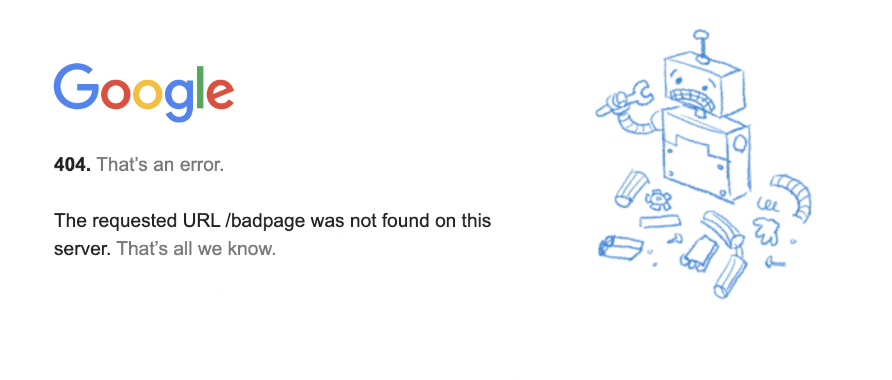In our last blog post, we talked about how your website is a building. It takes blood, sweat, and yes, tears, to create a website that’s fully functional with a UX design that’s easy to use.
But when a house is built, you aren’t just done with the house. You have to maintain the house. Because while you built a great product, you have to vacuum it every week. You have to clean the kitchen. When the roof springs a leak, you have to get it fixed quickly, or else the structure could be compromised.
Just like a building needs regular cleaning and maintenance, your website needs to be maintained as well.
Websites are not just a one-and-done project. Your website needs to be updated, backed up, tested, and more on a regular basis. Doing regular site maintenance not only protects your website but improves your search engine optimization (SEO) and makes Google more likely to put you in the #1 spot on their search engine results page (SERP).
Beef Up Your Security: Website Maintenance Protects You
A website is not the kind of project where you can just set it and forget it.
You must allocate a website budget every month to complete maintenance.
When you don’t complete regular website maintenance, you are asking for hackers to break into your house and steal your personal business information.
Your website will start to run slow, making it harder for people to use. And if you don’t keep up with ADA compliance, you can be sued, racking up hundreds of thousands of dollars in legal fees.
If that’s not enough to convince you, 43% of all cyber-attacks are targeted at small businesses. This is because hackers know that a small business doesn’t have as strong of security AND is more likely to not keep their website updated. This leaves holes in the code that they can use to get your information and your customer’s information.
Just one more stat to put the fear of God in you: in the US alone, an average of just under 200 million digital records have been compromised per year since 2015.
Don’t let your website crumble and do regular maintenance.
The Bare Minimum Website Maintenance
Just like with website design, website maintenance is extremely technical. To make sure it’s done correctly, you should keep a website design firm on retainer (like e9digital) to complete everything for you. A small website may only need an hour or two every month if an expert is handling it.
But, if you want to shed tears of frustration and do it yourself, these are the absolute bare minimum requirements for site maintenance.
“Much like a car, a website needs regular maintenance to run optimally. If neglected for long enough, issues can compound and you may face a hefty bill to get it back up and running–or possibly even need to consider getting a new one.” - Jason Solak, Project Manager
1. New is Best: Perform Every Update
Web hosting services are always updating their products to make a better experience for you and your users. They launch updates constantly; to boost security, implement a new feature, or update an issue with any part of their services.
You must download and install every single update released.
Many web hosting services email you when a new download is out but you should also make a manual reminder in your calendar to check for them just in case you miss the email. Sometimes there’s a bug in an update, so you need to download any subsequent updates because they will contain the fix.
If possible, do these updates outside of when people are most likely to visit your website. This allows you to install the update and troubleshoot for errors without disrupting your lead generation.
2. Back It Up On the Dance Floor and Your Hard Drive
When trying to do your own website maintenance, it is easy to make a mistake so bad that you have no idea what you did. It’s like when you’re trying to fix your car off a YouTube video, and you get in too deep and have to call a repairman to come over and figure it out (just another reason to keep a website design agency on retainer).
Always have a backup of the most recent version of your website and follow the 3-2-1 rule, which is:
- 3 backups in
- 2 forms of media with at least
- 1 stored offsite
This method was developed by photographer Peter Krogh in his book The DAM Book: Digital Asset Management for Photographers and is recommended as a best business practice by the Cybersecurity and Infrastructure Security Agency (CISA).
Do not just rely on the web host site to save the data.
You always want to have control of your website data in case the web host site makes an error that ruins the backup stored there.
This is one of the rare situations in life where listening to your anxiety is a good thing. You must assume the worst could happen and follow the 3-2-1 rule.
3. Don’t Sleep With the Fishes: Test It Regularly
Have you ever tried to click on a website link and all it says is: 404 not found?

Robert Calliau, who was one of the collaborators for the world wide web, says the 404 comes from a list of client errors when they first worked on the internet. They were called “400s” and number 4 was for “not found.”
404 is now the standard error message for a linking issue within the website. Whoever owns the site has not been testing it to see if it works.
You need to complete a full website test to remove all dead links, broken links, and duplicate web content because these confuse Google.
It’s easy enough to check the home page or other important landing pages on your website. But to dig into blog content and make sure every single page you’ve ever made is working properly, you’ll probably want to chat with a website maintenance company or pay for software like Semrush that can scan your website for errors.
Go Above and Beyond: Site Maintenance Best Practices
Yes, you could just do the three things listed above and you’re technically doing site maintenance.
But you don’t want your website to get a C grade, you want your website users to give your website an A+.
So, to make your website the best in the class, be sure to add these two best practices to your website maintenance regimen.
1. Speed Is Key: Make Sure Your Website Loads in 3 Seconds
Patience may be a virtue but not when it comes to websites. 25% of web users will leave a site if it doesn’t load in 3 seconds.
Sure, you want your website to load fast, but you did it all yourself and you can’t figure out why that nice image you spent tons of money on takes 15 seconds to load?!?
To make your website load faster, you need to improve your page loading speed. Yes, of course with enough time and headaches, you can fix this on your own. But this is something a professional could do quickly.
However, if you want to try to fix it yourself, here are a few items to look into that are simple.
- Go with a performance-optimized web host that doesn’t use shared hosting.
- Compress images so they load faster.
- Remove any unnecessary plugins.
Unfortunately, page speed comes from complicated tech updates, like redirects (401, 301, and 302), synchronously loaded CSS and JavaScript files, and CMS and HTTP requests. So while you can try the easy stuff to fix your page speed, there may be a bigger issue at hand.
2. Appeal to the Masses: Implement A/B Testing
So you work hours to craft the perfect call to action for your homepage, only for your website to go live and you have a super low click-through rate.
The click-through rate is how often someone sees an ad or call to action (CTA, which is whatever you want someone to do when they visit your web page) and actually clicks it. You want this rate to be at around 2 to 5%. This means that for every 100 people who visit your website, two to five people click on the CTA.
The way to figure out how to improve a certain action on your website is through A/B testing.
Let’s say your current CTA isn’t working how you want it to.
Keep the current webpage as your control, the A. Then, create a second version with the new wording, which is called B. Then, you test these versions against each other in a battle to the death by setting up the website so that half the visitors go to one and half go to the other.
To do that, you need to use marketing software like VWO or simply hire a digital marketing agency to do the testing for you.
Even if this seems like a hassle, A/B testing is the only way to see solid results and improve your Google click-through rate.
Don’t Let Your House Fall Into Disrepair – Work With e9 digital
Every neighborhood has that one house that’s overgrown with weeds and looks like it’s haunted. Remember, your website is a house— and you need to take care of it.
Don’t let your beautifully crafted website become the next neighborhood haunt and hire the web design experts at e9digital to complete your website maintenance.
And if you don’t want to hire someone to do maintenance, we can create a stunning website for you and set it up with a content management system (CMS) so you can do all the maintenance yourself.
So whether you can’t hack it alone or are a DIY guy, contact the website designers at e9digital to get started on your website today.
And once you’re done, head on over to our next e9digital’s Top SEO Tips post where we’re gonna show you the ropes behind the role of webmaster.

